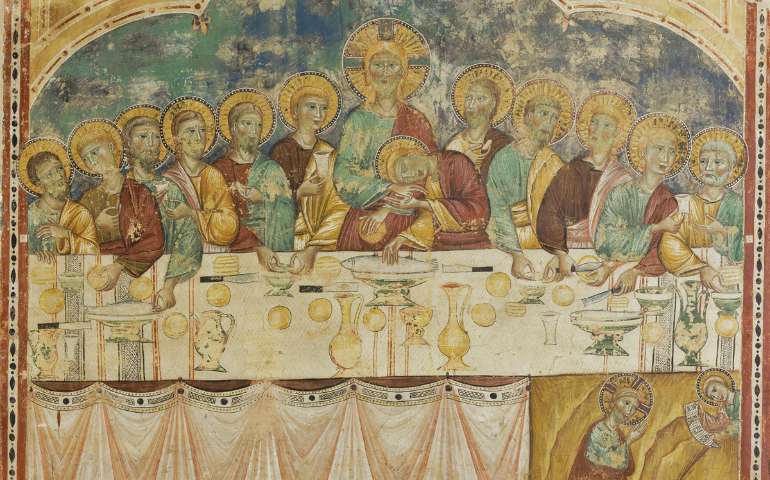
Detail of "The Last Supper and the Agony in the Garden," Spoleto, Italy, circa 1300, fresco transferred to canvas (Courtesy of Worcester Art Museum)
When he first saw "The Last Supper and the Agony in the Garden" at the Worcester Art Museum in Massachusetts, Jeffrey Forgeng was puzzled by the choreography of the circa-1300, Central Italian fresco, later transferred to canvas. Jesus appears where you'd expect him, towering over 12 apostles. The problem lay in the golden circles above their heads.
"The halos are a giveaway that Judas isn't there. That seems really weird," said Forgeng, who in 2014 became the museum's first curator of arms, armor and medieval art.
After studying the work extensively, Forgeng understood two aspects of the Last Supper. On the "angsty, unpleasant side," Jesus tells the group, "One of you shall betray me." This painting emphasizes a component other than the betrayal — the Christian fellowship of a shared meal, which unifies members of the church and lays the framework for the ritual of the Mass. The work was created for a nunnery, so the nuns, who shared daily communal meals, would have found personal significance in the fellowship theme.
"It basically edits Judas out and substitutes in maybe St. Paul or St. Matthias," Forgeng said. "It gives you this convivial banquet scene, and it lavishes attention on the place settings and on how the diners are sharing cups with each other in typical medieval fashion."
The work is one of several that Forgeng uses to teach visitors about religious subjects depicted in medieval art. "There's something kind of weird happening in this image, but the weirdness has a purpose. You look at the pieces and you say, 'Yeah that makes sense,' " he said. "Even if you don't believe the story, you can understand it as a story."
Good storytelling is crucial when sharing works that are hundreds of years old, particularly in a time when attention spans are rumored to be shorter than ever. That shouldn't jibe with medieval objects, which require patience and imagination to understand. Yet fascination abounds on TV and in movies, games and books for the Middle Ages — whose very name conveys a sort of halfway house between antiquity and modernity.
The widespread appeal of "medieval-seeming materials" drives students to enroll in medieval literature classes at George Washington University in Washington, D.C., said English professor Jeffrey Cohen, who directs the Institute for Medieval and Early Modern Studies there.
But parallel to that looms what he calls a "dark side of this resurgent interest in all things medieval." Just before World War II, there was a similar fascination with medieval materials, and extremists today are drawn to the Middle Ages, "especially via ardent fantasies of racial purity and white origins," Cohen said.
Lisa Fagin Davis, executive director of the Medieval Academy of America, the world's largest medieval studies advocate, has seen similar momentum.
"We all know what brings students and museumgoers through our doors. 'Game of Thrones,' Lord of the Rings, 'Vikings,' Harry Potter, film, even 'Dungeons & Dragons' and pseudo-medieval video games all feed the flames of medieval fandom," she said. "It's our job to take that enthusiasm and direct it toward productive and fact-based pedagogy."
But she has also observed the dark side of interest in the period that followed the Dark Ages.
"Given the increasing misappropriation of medieval crusader rhetoric by American white supremacists and the constant misinterpretation of movements like [the Islamic State] as 'medieval,' just to name two examples, our work is more important than ever," she said. "As scholars who grapple with the complex, multivalent and multicultural Middle Ages, it is incumbent on us to work to set the record straight."
At the University of Notre Dame, where Robin Jensen teaches the history of Christianity, undergraduates gravitate toward the Middle Ages more than they do to prior or subsequent periods.
In a time when the world can seem scary, Jensen wonders if fantasy and escapism appeal particularly to students. That surfaces in the courses she teaches on the Virgin Mary in art as well, where students are drawn to the Virgin's beauty and role as Queen of Heaven and to saints' supernatural powers.
"I think, for many people — especially college-age and millennials, perhaps — the medieval world seems somehow enchanted compared to a 'real' world that might seem hard and mean," she said. "We long for the spiritual, I think, even if we don't know exactly what that means, and even if we have rejected organized religion, especially Christianity."
In Worcester, Forgeng sees a different kind of relatable aspect to medieval art. He noted three depictions of the Virgin Mary at the museum: a 12th-century Romanesque, life-sized sculpture; a slightly smaller Virgin and Child from the 13th century; and a 14th-century, almost life-sized Virgin and Child. The works reflect the transition from the Romanesque period's formality, severity, austerity and symmetry to the more naturalistic and humanistic representation of human figures in Gothic art.
The three Marys serve as values on a historical line upon which one can chart the transition from the earlier world, where it was a struggle to meet basic needs such as security, stability and order "in a post-Roman world where everything seemed to be going to hell in a hand basket," Forgeng said, to the later Middle Ages, which were very different. Institutions had been in place for a long time and presented stability, and more wealth flowed to what was a growing quasi-middle class. "You start to see a more emotional form of religion," he said.
In that sense, Forgeng added, the world isn't all that different today, which makes even medieval objects relevant and timely. The museum frames the pieces that way to help visitors connect to them. "We tried not to bombard viewers with too much religious detail, because it would really overwhelm people," he said.
Some 1,750 miles southwest from Worcester, the Dallas Museum of Art is also helping viewers better understand the Middle Ages. In 2013, the museum received a gift of $17 million from the Marguerite and Robert Hoffman Fund to focus on European art prior to 1700. The funding places the museum in a "rather unique position amongst its peers," said Nicole Myers, curator of European painting and sculpture.
"One of the barriers to cultivating a passion for medieval art among modern viewers is that we are looking at objects that are deeply decontextualized, whether fragments of architectural elements that originated in Gothic cathedrals or liturgical objects that have been isolated from the rich environments in which they would have been used and observed by medieval men and women," Myers said.
In the Dallas Museum of Art's recent exhibition of some 100 objects from an important medieval museum collection in Paris, "Art and Nature in the Middle Ages," such severed context arose often.
"Many of the medieval objects in our exhibition would have been seen together as a whole, working together to produce a sense of awe and devotion in its audience," Myers said. "Many of the objects also seem to demand a certain level of knowledge about their use in the medieval home or church, or the stories and symbolism associated with the subject matter depicted."
The sense of wonder and mystery that comes from that context makes the objects even more appealing, particularly given the fragile objects' survival against all odds, in the face of iconoclasm, revolutions, fires and wars, Myers said. And the religious context around the works is also important.
"In pre-modern times, religious bodies like the Catholic Church were the primary patrons of art production in Western Europe. Without its drive and financial power, we wouldn't have had the explosion of visual arts in a stunning array of materials, techniques and types during Middle Ages," Myers said. "Religion was the driving force behind much of the European art produced in this period, and it led the way to groundbreaking technical innovations."
[Menachem Wecker is co-author of the book Consider No Evil: Two Faith Traditions and the Problem of Academic Freedom in Religious Higher Education.]




